Triumph of Spring (Fortune: Evolution Game)
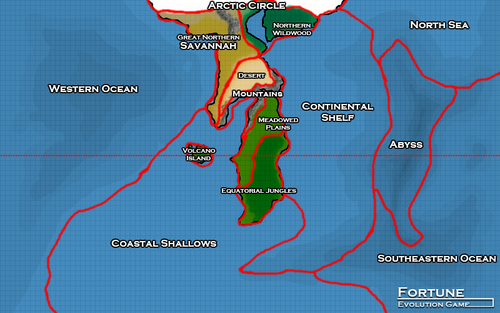
The Triumph of Spring is the name given to the fifth part of the Fortune: Evolution Game. It is set after the end of the Ice Age that comprised parts 3 & 4. The name was first used here on 1d4chan, and was discovered by the players in the midst of Discussion Thread 2. Triumph of Spring introduced a new map, with a variety of environments and a reworked continent (shifted by continental drift etc.). It also introduced a new landmass, called Volcano Island, formed as a result of the massive eruption that led to the end of the Ice Age.
This article/entry is for additional details and fluff concerning the starting organisms available at the very start of the thread, along with behind the scenes information about the creation and development of the species by FortuneHost and the players.
Animals
Aquabeast

The Aquabeast is a carnivorous aquatic repto-mammal that lives in cold saltwater habitats, usually inhabiting the mid-range to deep ocean depths. It makes its home in the Continental Shelf and the North Sea Regions.
The Aquabeast is about the size of a whale shark, roaming the mid to near-surface depths of the ocean. While most of its body is covered in dense bony armor, its underbelly is adorned with slick blue hairs, stuck close together, similar to a penguin's feathers. Being such a large beast, this creature's digestive system is wonderfully efficient, even the bones of prey are digested. The calcium present in these goes to the upkeep/growth of the Aquabeast's impressive armor (which, is actually a modified second skeleton). While the Aquabeast is only moderately fast, it does have the advantage of a long tongue, one that can extend it body length away. In this regard, the Aquabeast has changed little from its Spineback predecessor, it remains an ambush predator, relying on a single decisive strike to grab prey before it has a chance to react.
Arctic Serpent

The Arctic Serpent is an arboreal mammal whose main diet consists of insects and prefers forests with a cold to temperate climate. They are found in the region known as the Northern Wildwood.
The Arctic Serpent is one of Fortune's few mammals, giving live birth and with lactating females. While their ancestors burrowed underground to escape the cold, since the meltdown, they have returned to their arboreal routs, hanging in the boughs of trees in groups of up to a dozen. Here they eat the many insects that are (suprisingly) common in Fortune's colder regions. The Arctic Serpent is probably about the size of a large dog, like a Great Dane.
Barkworm
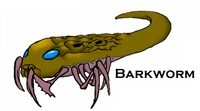
Barkworms are omnivorous insectoids that make their homes inside burrows carved out of tree-trunks. They are found wherever there are trees, and so are most common in the regions of the Northern Wildwood and the Equatorial Jungles.
Barkworms are a creatures that has changed very little in millions of years. They inhabit the inside of trees, helping to clean out dead bark and rotten roots, the way cleaner fish pick dead skin off larger fish on Earth. The Barkworms will also not hesitate to eat deceased animals either, provided they are not far from the creature's burrows (such burrows are either bored into the tree itself or are in the dirt beneath its roots).
Barkworms are about the size of a human hand.
Beach Crab (Spearfishing Crab)
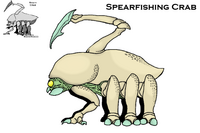
The Spearfishing Crab, sometimes shortened to just Spearfisher, is a terrestrial crustacean, that, as its name implies, eats mainly small fish that it catches with the brutal "hook" atop its back. It is found along the the warm, sunny coasts and beaches of the Meadowed Plains and the Equatorial Jungles.
(More description to be added at a later date.)
Blind Burrowing Snake
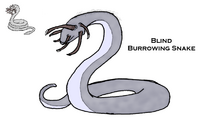
Blind Burrowing Snakes are subterranean mammals with an omnivorous diet (roots as well as insects). They are found in the following regions: Meadowed Plains, Equatorial Jungles, & the Northern Wildwood.
Due to a random mutation deep in its past, the Blind Burrowing Snake lost its eyes, to be replaced with short digging arms, each possesed of a single thick "fingernail"-like structure.
These creatures give birth to live young, about 2-4, and upon emergence, sniff out their mothers teats, and survive on a diet of milk until about 3 months, after which their mother weans them onto insects and roots.
The snakes live in small family groups, consisting of around 10-20 individuals and live in an extensive warren, not unlike Earth's prarie dogs.
In terms of size, Blind Burrowing Snakes are around the length and thickness of a human arm.
Bloat, Land (Gardenback)
This creature was named by the fans/players, as FortuneHost couldn't think of a decent one when it was submitted.
(Description to be added at a later date)
Bloat, Sea (Rainbow Blimpie)
(Description to be added at a later date.)
Bloat Whale

(Description to be added at a later date.)
Chomper, Bull

Bull Chompers are terrestrial herbivorous repto-mammals that live in the high tops of mountains and other alpine environments. As such, they are only found in the Mountains region on Fortune.
Gorilla-sized mountain herbivores, the Bull Chomper is an offshoot of the "Thumbed Chomper". Developing in the mountains, the Bull Chompers fur became thicker, shaggier, and turned a deep black. This colour change served to absorb more of what little heat it recieved high in its alpine home. Surprisingly, it also serves as camoflauge. Bull Chompers will bury their bodies in the snow, and look for all the world (to hungry predators at least) like a rock formation jutting out of the snow.
Bulls Chompers travel in herds of about 5-10, a single alpha male and his "harem" and children, like lion prides on Earth. An alpha male possesses a bright red "mohawk" a symbol of his status, but one that only develops once a male has a herd of his own (similar to the change that turns male gorillas into silverbacks).
Most young males will wander alone, never to be seen save during mating season. It is during this time that the alphas are formally challenged (with headbutting reminiscent of musk oxen) , though sometimes while fighting, other males will sneak in and mate with the females, who have no qualms 'cheating' on their alpha. Any products of these unions are allowed to hatch, but as soon as the young can walk, the alpha will chase it from the herd. Bull Chompers, like most of Fortune (save for the Arctic Serpents & Blind Burrowing Snakes) lays clutches of eggs. One hallmark of the various Chomper species is that they lay only a few eggs (one or two at a time) and then raise them to adulthood.
The Bull Chomper possesses thick calluses on the ends of its knuckles, these serve as dextrous "hooves" that assist the creature in staying steady on high mountaintops much like Earth mountain goats.
Chomper, Camleback
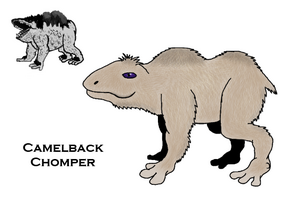
Camelback Chompers are terrestrial repto-mammals found in temperate to dry plains & steppes as well as deserts. They subsist on a herbivorous diet and are found in the regions of the Great Northern Savannah, the Desert, and the Meadowed Plains.
Camelback Chompers are horse-sized nomadic herbivores that are built to survive harsh, dry conditions. They mainly do this through the use of the fat cells stored in their "hump", allowing for them to, in emergency or drought, to survive for about 3 weeks without food, noticeably shrinking their humps. Should this happen, the Camelback will gorge at the next opportunity, attempting to replace the lost storage. Their bodies are also adept at storing water, including thick jowls (like a Bloodhounds) that trap saliva in the cheeks, allowing it to be reused rather than lost via drool/evaporation.
Camelbacks travel in herds of anwhere from a dozen to nearly a hundred animals, grazing and lazily migrating across their habitats. These herds are the primary family unit, and while hatchlings are cared for mainly by their biological parents, Camelbacks often have a group of older females past breeding age that act as a sort of "daycare" for the herd as a whole (similar to meerkats on Earth). Camelbacks even have the curious practice of "adoption", where, if the parents of a baby or juvenile Camelback perish, a mated pair without a child of their own will take the youngster in. At times this is done even if the mated pair already has a child, and other times one of the non-breeding "daycare" females will take the orphan in.
(Chomper) Smiler
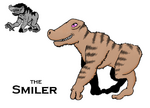
The Smiler, or Smiling Chomper is a herbivorous terrestrial repto-mammal that lives in forests or plains of almost any sub-arctic climate, being found in the Great Northern Savannah, the Meadowed Plains, and the Equatorial Jungles regions of Fortune.
The Smiler is a gorilla sized herbivore that travels in family groups not unlike Earth chimpanzees. The trooop is led by a leading mated pair, and child-rearing is overseen by all females of the group. They are most at home in grasslands, but the species does well in forests too. Smilers are well known for their use of tools, unique on Fortune. They use the spikes of the Spineroot plant to dig up large roots and tubers as an alternative to their regular diet of grasses. It should be noted, though, that there is no sense of ingenuity or invention in this, and that it is almost purely instinct. For now, the Smiler's intelligence has plateaued.
Smilers get their names from the creepy looking grin that, because of their jaw structure and musculature, is permanently etched onto their faces.
Demolisher (Spineback)

(Description to be added at a later date.)
Featherscale
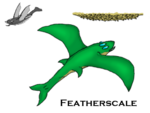
Featherscales are carnivorous fish native to warm-to-tropical waters of the Coastal Shallows and Western Ocean regions.
These wolf-sized predators are exclusively adapted for hunting Sea Bloats, to the point that *any* change in the Sea Bloat population has a corresponding and profound effect on Featherscale numbers.
The main hunting tactic of the Featherscale is to "wind-up" the muscles in their tail, putting all their energy into a tremendous burst of speed, and leaping out of the water. From their, the creatures glide for several minutes, attempting to spear any Sea Bloats with their mandibles. Eventually, though, the Featherscale must return to the water (as it does not possess lungs, only gills), and gravity takes its toll. Ideally, the creature will have snagged a Bloat, floating on the surface and ripe for the picking. If not, the creature will have to try again later, when it cathes its "breath".
Featherscales lay thousands of soft slimy-coated eggs in underwater caves disguised with sea-flora. The young hatch into small thumb-sized fry that must fend for themselves from the moment of birth. On average, only around 7% reach adulthood.
Grey Wretch

The Grey Wretch is a carnivorous terrestrial repto-mammal that makes its homes in Fortune's cold to temperate forests and plains, being found in the regions of the Mountains, the Northern Wildwood, and even the Arctic Circle.
Grey Wretches are grizzly bear-sized solitary predators of the north, though they are also sometimes seen in pairs. Interestingly, Grey Wretches (like their ancestors) only seek breeding partners near the very end of their lives (somewhere along the last few months or so), and when they spawn, their death soon follows (similar in this respect to Earth's salmon population).
The female lays up to a dozen or more football-sized eggs, burying them in a large pile of dirt or snow-drift. When the young hatch, they are about the size of a chihuaha, and stick together for safety, catching insects and other small prey, until they are old enough for larger game. Once they reach 60% of their adult size, the juvenile Wretches part, leading solitary lives, though by this point, there is rarely more than 5 of the original clutch left.
Ice Bug
Ice Ray
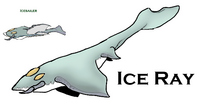
Ice Rays are carnivorous fish that make their homes in the arctic to temperate waters of the Western Ocean, North Sea and Continental Shelf regions, being found at Near-Surface to Mid-Range depths.
Ice Rays have flat manta-ray like bodies and hunt either solitarily or in a mated pair. They mate for life, and in fact, if one of the pair dies, the other will waste away, refusing to eat, seemingly mourning its lost partner.
Ice Rays are semi-nocturnal, occasionally hunting at night, where they come closer to the surface. Here, in the moonlight, at seemingly random intervals, they gracefully somersault and backflip in the water. These hauntingly beautiful "dances" are a complete mystery, and no one has any idea as to why they are performed.
Ice Rays are near the size of a dolphin, but almost 2-3 times as wide, owing to their "wingspan", the modified fins that 'flap' through the water, providing locomotion.
Piranha Fly
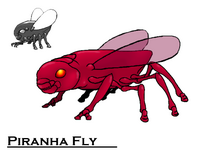
(Description to be added at a later date.)
Proboscis Scorpion
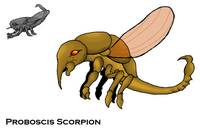
(Description to be added at a later date.)
Raveshark, Abyssal (Ravedragon)
(Picture and description to be added at a later date.)
Raveshark, Common (Midnight)
(Picture and description to be added at a later date.)
Raveshark, Shadow
(Picture and description to be added at a later date.)
Rock Leech
(Picture and description to be added at a later date.)
(Rock Leech) Common Stinger
(Picture and description to be added at a later date.)
(Rock Leech) Parasitic Stinger
(Picture and description to be added at a later date.)
Sail Flipper (Windsail Dolphin)

The Windsail Dolphin is a carnivorous fish native to the temperate to tropical waters of the Continental Shelf and the Southeastern Ocean, and can be found in Near-Surface to Mid-Range depths.
The Windsail Dolphin uses its large fins to be blown around by the wind, conserving energy by letting the breeze and tides carry them. Windsails are about as big as their dolphin namesakes, and have a similar diet, mostly small fish.
Why the sails developed is unknown, but the features get plenty of use during the semi-annual migration of the species, travelling from one end of the planet to the other. For a few years, the species lives in the tropics of the Continental Shelf, slowly moving southwards, until, 3-5 years later, they near the edge of the region and begin migrating towards the more temperate waters of the south-end of the Southeastern Ocean, gradually moving north, from whence they will return to the northern Continental Shelf.
This long process is in place to avoid "overfishing" an area, gradually moving once food hits a certain low, and returning many years later when prey populations have recovered.
Saltback Frog

The Saltbacked Frog, or simply Saltback is a terrestrial amphibian that dines almost exclusively on the Salt Ginger, a plant that grows on the banks of freshwater bodies in warm to tropical areas as well as swamps and wetlands of a similar climate. Thus it is that the Saltback dwells here also, being native to the Equatorial Jungles region of planet Fortune.
While the creature has lost its shell since evolving from the Shellfog, the Saltback does retain a decoration of sorts, an assortment of salt crystals adorning its back (hence the name). This is the result of the creature's body filtering out the high sodium content of its diet, too much of which will dry the Saltback out like a slug. As the frog matures, it forms a hard "shell", while astonishing to look at, it does not provide any sort of protection. Said display, is, however sometimes used in courting rituals, as a thick crust of the stuff indicates the individual is well fed, and thus both healthy and smart enough to stay alive by avoiding predators.
Saltbacks are small, the biggest are around the size of an outstretched palm. That said, these small critters are a prolific bunch, not to mention loud. During the mating season (anywhere from late spring to midsummer), males and females will croak to each other, and within these chirps and ribbits, the health, size, age, and gender of the frog making them is made apparent (to other Saltbacks, anyway).
When a frog hears a mate that it likes, it will follow the sound to the caller and try to initiate the courtship dance. If the other accepts, they will mate and lay a foamy mass of around 700 of eggs. The pair will then separate, not to see each other again, except perhaps next season. The young are but miniature version of the adults, unlike Earth frogs, though they do breathe through gills at this stage, eventually, these gills will be replaced with lungs as the young mature.
Shogun Walrus

Walrus-sized slime/jelly creatures native to the Meadowed Plains, Great Northern Savannah and the Arctic Circle, the Shogun Walrus is a strange dirt-eating, acid spitting oddity. It has two stomach cavities, one of which leads up to its "nostrils", which are in fact tubes through which virulent stomach acids may be fired at predators. That said, the walruses don't have too many enemies, as they taste terrible and they're bodies are highly acidic, especially near the nostril cavities (from where they fire their attack) and the tail (where their mouth is located).
The Shogun Walrus reproduces via fission. An individual grows in ever-so-slightly in size when it eats, and when it reaches a certain critical mass, it splits into two creatures, the original and a smaller, hairless verison. This newborn will gain its long coat of fur as it matures into adulthood.
Skullroot
(Picture Complete)
Skullroot, Deathmasque
(Picture Complete)
Snow Beetle
(Picture Complete)
Snow Crab
(Picture Complete)
Snow Tick
(Picture and description to be added at a later date.)
Spitter Crab

Spitter Crabs are omnivorous, terrestrial crustaceans common to the Northern Savannah and Meadowed Plains regions. The vast majority of the crab's diet is vegetable matter, but every once in a while, the creatures will scavenge, dining on dead creatures. They have never been observed chasing or hunting prey, and it's likely they do not do so.
(More description to be added at a later date.)
Tentacle-Eating Leech
(Picture Complete)
Webspinner (Silt Spinner)
(Picture and description to be added at a later date.)
Plants
Alpine Herb
(Picture and description to be added at a later date.)
Asparagus Tree, Common
(Picture and description to be added at a later date.)
Asparagus Tree, Steppes
(Picture and description to be added at a later date.)
Bloodsucker Lichen
(Picture and description to be added at a later date.)
Bluegrass, Common
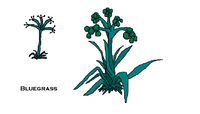
(Description to be added at a later date.)
Bluegrass, Dwarf

(Description to be added at a later date.)
Boom Ginger
(Picture and Description to be added at a later date.)
Ice Shrub
(Picture and description to be added at a later date.)
Mud Shrub
(Picture and description to be added at a later date.)
Salt Cactus
(Picture and description to be added at a later date.)
Salt Ginger
(Picture and description to be added at a later date.)
Snow Shrub
(Picture and description to be added at a later date.)
Spineroot
(Picture and description to be added at a later date.)
Vampire Lily, Common
(Picture and description to be added at a later date.)
Vampire Lily, Flowering
(Picture and description to be added at a later date.)
Vampire Lily, Giant
(Picture and description to be added at a later date.)
Water Berry Groves
(Picture and description to be added at a later date.)